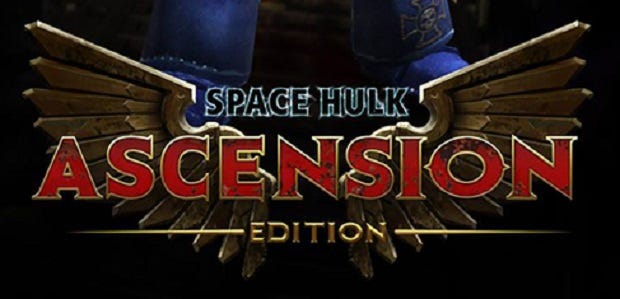Wot I Think: Space Hulk Ascension
Sometimes you SHulk, sometimes you burn
Space Hulk is back. Again. From developers Full Control, who were responsible for last year's digital release, Ascension is a sequel of sorts, with a new approach to campaigns, with persistent stat progression, and over a hundred missions. It's an improvement over the company's first attempt in many ways but there are still plenty of reasons to have a bit of a space sulk.
I appreciate digital conversions of boardgames, even though there's been an increased amount of cardboard in my life in recent years. There are many reasons to play on a computer rather than a table, ranging from the availability of a particular game or suitable players, to the complexity of setup and the time taken to play. Or perhaps, like me, you're foolish enough to embrace the unimaginable blasphemy of a fully expanded Arkham Horror, which requires more floorspace than I have in my current apartment.
Space Hulk's scarcity justifies the excitement that greeted the news of a new digital version. It's not a game that can derive many benefits from the conversion - unlike the aforementioned Arkham Horror, which requires its players to keep track of a hundred tokens and stoke the fires of the machine at its heart.
Space Hulk is relatively simple and attempting to complicate the design might well compromise its tactical brilliance. Forget the Warhammer 40k lore for a moment, cast aside the genestealers and Terminators, and consider what Space Hulk is actually about. It's a squad-based game about controlling space. As the squad advances across a map, whatever their ultimate object, their task on each turn is to lock down an area, plugging spawn points and junctions, and creating a defensive perimeter.
Often, the core challenge of a mission is in the requirement to move the perimeter across hostile territory, dismantling and reconstructing as new threats and targets become priorities. Varied weapon loadouts mean that some Terminators are suitable for standing guard, while others are best utilised as punchy frontline assault weapons. Occasionally, a specific piece of equipment is needed to complete an objective.
In an abstract sense, the Terminators are resources and the player, from a position of tactical oversight, shifts those resources into position, attempting to create an invincible entity made up of several moving parts. Precision is important - one mispent action point can cause the whole edifice to crumble - and Space Hulk Ascension's most striking problem is in the muddiness of its interface and graphics. It's hard to get a handle on the delicacy of a situation when the interface and maps are often obstructive rather than instructive.
The murkiness of the corridors and rooms means that it's difficult to pick out the details of the space you're attempting to control. I've failed to notice a door or vent because the surfaces blend into one another, and when a misunderstanding regarding the layout of the map is responsible for failure, I feel cheated. The same is true when I click to move a Terminator and leave him facing in the wrong direction - the margin for error when positioning units is so fine, given the clutter of the background graphics, as to be punishing.
Ascension is desperately in need of a clean tactical map, to sit alongside its moody isometric representation of the claustrophobic corridors. There's a first-person camera shown at the top-right of the screen whenever a unit is selected, and it's a lovely atmospheric touch that calls back to the 1993 adaptation and its panic-inducing time-limited engagements.
Robbing the Terminator player of the safety of a turn-based mode was the original computer adaptation's big gamble. Each mission, crucially, still followed the formula explained above - control of space and perimeters - but planning for survival and victory was a panicked and pressured affair. Ascension doesn't attempt anything quite so bold but does build on the boardgame and last year's release by introducing persistent abilities and choices across three campaigns.
The campaigns work. Three Space Marine chapters are represented, with the Ultramarines a completely new addition (the others are last year's Blood Angels and the Space Wolves, previously available as DLC). There are branching missions, weapon and skill upgrades and flash points at which mini-missions within missions are triggered, offering high risks for (possible) plentiful rewards.
It's a rich bounty, with more than a hundred missions across the trio of campaigns, and Full Control have given their digital adaptation a life beyond the tight rules of the boardgame, without directly contravening or discarding them. As well as automating genestealer movement, in a similar fashion to the boardgame's Deathwing expansion, Ascension adds layers of complexity in the guise of new weapon and enemy types.
However, no matter how intriguing the additions to the game are, the wrapper that contains it is about as robust as a balsa wood Logan Grimnar cosplay outfit. The combination of the sometimes illegible layouts and fog of war makes exploration a chore of zooming, checking and rechecking to make sure a misunderstanding won't lead to the death of your whole squad. The interface, with radial buttons appearing when a Terminator is selected, is fiddly rather than entirely unfit for purpose, but even after hours of playing I was running up against the same misclicks and mild frustrations.
The consequence of one major complaint - the lack of a clear tactical map - and many minor complaints is that I'm reluctant to recommend Space Hulk Ascension, despite the hugely improved campaign structure and increased variety. There's a good game hidden in the grimdark corridors, and it's best qualities aren't just borrowings from Games Workshop, but Ascension has taken two steps forward and one step back. And, as in the game, the backwards step is twice as costly.
Space Hulk Ascension is available now.












